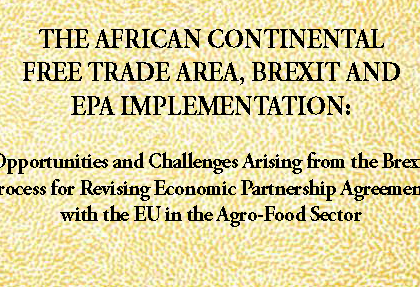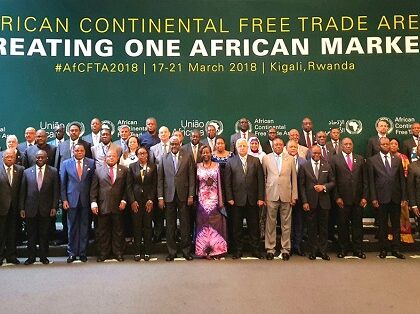The EU Proposal to the ESA Region Services, Investment and – e-commerce
Art 41 of the Cotonou Agreement which deals with Trade in Services underlines the following:
- Growing importance of services in international trade and their major contribution to economic and social development.
- Reaffirmation of commitments under GATS.
- In line with provisions of Art XIX of GATS, the community to give sympathetic consideration to ACP States priorities for improvement in EC schedule.
- Undertake liberalisation of trade in services in accordance with the provisions of the GATS, in particular those relating to the participation of developing countries in liberalisation agreements.
- Community’s support of ACP states efforts to strengthen capacity in the supply of services with a view to enhancing competitiveness and increasing the value and volume of trade.
The development of a framework for trade in services in the context of the ESA EPA negotiations, and the respective liberalisation schedules, should be based on the above guidelines as agreed by both of the Parties in the Cotonou Agreement.
The ESA approach to trade in services is squarely fitting this objective. It is built precisely on the architecture of the GATS (4 modes, full positive list approach) with the necessary flexibility to be accorded to the ESA States, complemented with a strong component on cooperation aimed at addressing the supply side and other constraints in the ESA region. Any improvement in commitments, will be made in GATS – type schedules in the context of the request/offer exercise.
The ESA approach is also consistent with the approach taken at the COMESA level. This South-South regional integration in services is a process moving in parallel with the EPA process. One of the important principles agreed between ESA and the EC is the need for coherence and consistency between the EPA and negotiations at the regional level, with the overall objective that any EPA should support regional South-South integration. In elaborating the ESA position and approach, the regional dimension was taken into account.
The EU’s EPA proposal to ESA countries suggests a chapter covering three pillars: cross-border trade in services (to cover basically Modes 1 and 2); investment in services and non-services activities (“Mode 3 plus”); temporary presence of natural persons for business purposes (“Mode 4 minus”). ESA Members States do not see themselves fit to adopt this approach. The following note sets out the economic, developmental, conceptual, capacity-related, and technical concerns with the EU negotiating proposal.
There are questions about the economic benefits ESA countries would reap from negotiations for comprehensive EPA investment liberalization in economic sectors other than services;
- The ESA region does not have the type of transnational and international companies that would benefit from investment liberalization provision and access to the EC market. Rather, the universe of companies engaging in foreign direct investments continues to be dominated by companies from the developed world; hence, whatever efficiency gains may arise for consumers from such liberalization, it would be mainly EC companies benefiting from any investment liberalization in the ESA region;
- There is no guarantee that investment liberalization through international agreements will attract development enhancing FDI. So far, it has not been possible to establish a causal link between international investment rule making and increasing FDI flows. [1] Hence, while the ESA region aims to attract FDI, market access (MA) and national treatment (NT) commitments for investments may not be the optimal way to proceed;
The ESA region is not yet ready to comprehensively negotiate investment liberalization for sectors other than services in the EPA context;
- The ESA region lacks experience with the comprehensive non-services-investment liberalization enshrined in North-South RTAs;
- Indeed, the above arguments about the lack of clear benefits apply to both, services and non-services investment. However, through the GATS, the ESA region has obtained experience with investment liberalization for select services sectors; this suggests that services investment is an area that can be considered for negotiation with the EU;
- Hence, the ESA region can only embark upon services investment liberalization, not on investment liberalization in sectors others than services;
- In so doing, a cautious approach to services liberalization under EPAs might be warranted. A cautious approach – as encompassed by the principle of “progressive liberalization”- will allow taking into account regulatory preparedness and competitiveness of each services sector in the region;
- Moreover, the ESA region is yet to complete the implementation of its regional framework on investment (Common Comesa Investment Area, CCIA) and the EPA process should support rather than undermine this South-South regional process;
The negotiation of investment liberalization as part of the three pillar structure is inconsistent with the negotiating mandate agreed upon in the ESA/EC interim EPA;
- In Article 53 of the ESA/EC interim EPA, the Parties agreed to negotiate, amongst others, “trade in services” and “trade-related issues namely…. Investment and private sector development”;
- Nothing in this provision calls for the negotiation of investment liberalization in areas other than those covered by “trade in services”. Moreover, further references to “investment” make clear that any negotiation of investment rules – other than services investment – shall be focused on cooperation;
- The ESA region counts on the EU’s good faith implementation of a negotiated agreement;
Countries that had concluded a BIT were nor more likely to receive additional FDI than were countries without such a pact (Worldbank, 2003); It is difficult to ascertain to what extent services IIAs contribute to increased FDI flows in services (, UNCTAD WIR 2004); There is no empirical evidence to link any significant increase in FDI flows to DCs with the conclusion of GATS (UNCTAD 2000).



